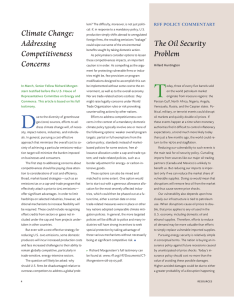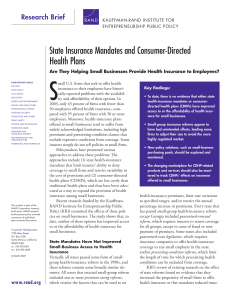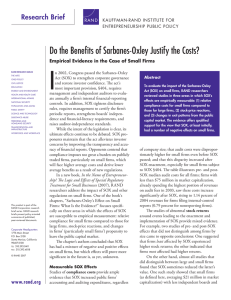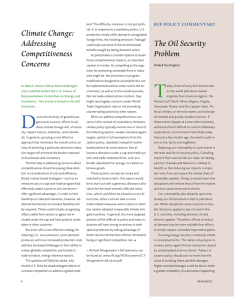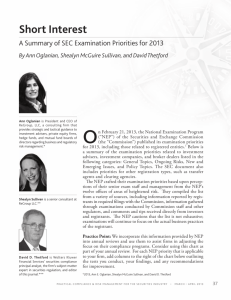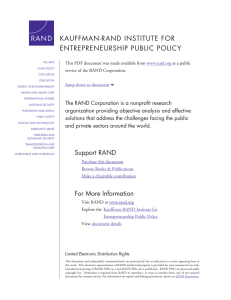S Is Special Regulatory Treatment for Small Businesses Working as Intended? Research Brief
advertisement
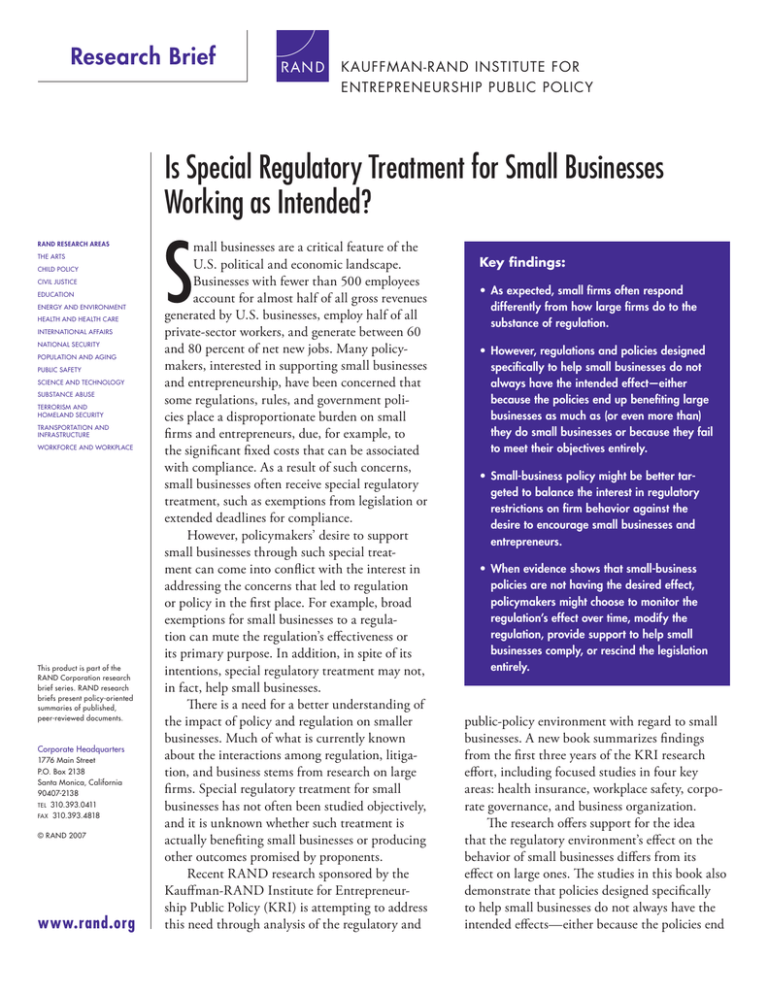
Research Brief KAUFFMAN-RAND INSTITUTE FOR ENTREPRENEURSHIP PUBLIC POLICY Is Special Regulatory Treatment for Small Businesses Working as Intended? RAND RESEARCH AREAS THE ARTS CHILD POLICY CIVIL JUSTICE EDUCATION ENERGY AND ENVIRONMENT HEALTH AND HEALTH CARE INTERNATIONAL AFFAIRS NATIONAL SECURITY POPULATION AND AGING PUBLIC SAFETY SCIENCE AND TECHNOLOGY SUBSTANCE ABUSE TERRORISM AND HOMELAND SECURITY TRANSPORTATION AND INFRASTRUCTURE WORKFORCE AND WORKPLACE This product is part of the RAND Corporation research brief series. RAND research briefs present policy-oriented summaries of published, peer-reviewed documents. Corporate Headquarters 1776 Main Street P.O. Box 2138 Santa Monica, California 90407-2138 TEL 310.393.0411 FAX 310.393.4818 © RAND 2007 www.rand.org S mall businesses are a critical feature of the U.S. political and economic landscape. Businesses with fewer than 500 employees account for almost half of all gross revenues generated by U.S. businesses, employ half of all private-sector workers, and generate between 60 and 80 percent of net new jobs. Many policymakers, interested in supporting small businesses and entrepreneurship, have been concerned that some regulations, rules, and government policies place a disproportionate burden on small firms and entrepreneurs, due, for example, to the significant fixed costs that can be associated with compliance. As a result of such concerns, small businesses often receive special regulatory treatment, such as exemptions from legislation or extended deadlines for compliance. However, policymakers’ desire to support small businesses through such special treatment can come into conflict with the interest in addressing the concerns that led to regulation or policy in the first place. For example, broad exemptions for small businesses to a regulation can mute the regulation’s effectiveness or its primary purpose. In addition, in spite of its intentions, special regulatory treatment may not, in fact, help small businesses. There is a need for a better understanding of the impact of policy and regulation on smaller businesses. Much of what is currently known about the interactions among regulation, litigation, and business stems from research on large firms. Special regulatory treatment for small businesses has not often been studied objectively, and it is unknown whether such treatment is actually benefiting small businesses or producing other outcomes promised by proponents. Recent RAND research sponsored by the Kauffman-RAND Institute for Entrepreneurship Public Policy (KRI) is attempting to address this need through analysis of the regulatory and Key findings: • As expected, small firms often respond differently from how large firms do to the substance of regulation. • However, regulations and policies designed specifically to help small businesses do not always have the intended effect—either because the policies end up benefiting large businesses as much as (or even more than) they do small businesses or because they fail to meet their objectives entirely. • Small-business policy might be better targeted to balance the interest in regulatory restrictions on firm behavior against the desire to encourage small businesses and entrepreneurs. • When evidence shows that small-business policies are not having the desired effect, policymakers might choose to monitor the regulation’s effect over time, modify the regulation, provide support to help small businesses comply, or rescind the legislation entirely. public-policy environment with regard to small businesses. A new book summarizes findings from the first three years of the KRI research effort, including focused studies in four key areas: health insurance, workplace safety, corporate governance, and business organization. The research offers support for the idea that the regulatory environment’s effect on the behavior of small businesses differs from its effect on large ones. The studies in this book also demonstrate that policies designed specifically to help small businesses do not always have the intended effects—either because the policies end –2– up benefiting large businesses as much as (or even more than) they do small businesses or because they fail to meet their objectives entirely. The Regulatory Environment’s Effect on Small-Firm Behavior Can Differ from Its Effect on Large Firms KRI research provides evidence that small firms can respond differently from the way in which large firms do to the substance of regulation. For example, one study examined the effects of the regulatory regime created by the SarbanesOxley Act of 2002 (SOX). SOX, which was enacted to restore investor confidence in the wake of a series of corporate accounting and security scandals, requires firms to establish a set of internal procedures to ensure accurate financial disclosure and to engage an outside auditor to assess the effectiveness of the firm’s internal controls. Because small firms have fewer resources, enjoy fewer economies of scale, and receive relatively little investor attention compared with large firms, they potentially face higher average costs and derive lower average benefits from SOX. At the same time, small firms’ public investors may also benefit more than others from the assurance that SOX provides, since small companies have historically been more prone than large firms to financial fraud. The researchers found that small firms appear to have responded differently to SOX implementation than large firms. In particular, the study found that, in the first year after SOX implementation, the probability that small firms exited from public markets (by arranging for private acquirers to buy their entire stock) increased by more than 50 percent, whereas there was no effect for larger firms. However, no effect was seen for either small or large firms in the second year after enactment. These findings indicate that, while small firms can respond differently from how large firms do to the regulatory environment, the different behavioral effect may be short-lived. Moreover, it is possible that the quick exit of many small firms from public markets was due to the fact that these firms were inadequately prepared to comply with the new policy environment, while those that remained in the public market were not affected. In other words, the policy may have had a corrective effect on the marketplace. Further research would be needed to determine whether this interpretation is accurate. Policies Designed Specifically to Help Small Businesses Do Not Always Have the Intended Effect KRI research has also identified several instances in which policies designed to help small businesses have not had the expected effect. Health-Insurance Options One example concerns health-insurance options for small businesses. Small firms that seek to offer health insurance to their employees have historically reported problems with the availability and affordability of their options. Policymakers have pursued various avenues for regulating the small-group market, including state health-insurance mandates, which restrict premium variability and restrict insurers’ ability to deny coverage to small firms. Consumer-directed health plans (CDHPs), which are less costly than traditional health plans, have also been advocated as a way to expand availability of health insurance among small businesses. KRI research shows that, to date, neither of these options has improved access to or the affordability of health insurance for small businesses. For example, despite the enthusiasm for CDHPs among small-business advocates, evidence to date suggests that small businesses have been no likelier than larger businesses to offer such plans and that the adoption of CDHPs has been higher among larger firms than among smaller ones. The research found even more discouraging results regarding the effects of state health-insurance mandates that were designed to expand small businesses’ access to health insurance through regulation of the small-group market. In this case, the research found no evidence that these policies increased the propensity of small firms to offer health insurance or that they reduced premiums. Moreover, the study provides evidence that firms near the threshold for exemption from the regulated health-insurance market tended to increase their size to avoid the more highly regulated market. These findings suggest that modifications to current health-insurance regulations may be needed. Organizational Forms Another study in the book showed that new organizational forms designed in part to benefit small businesses also appear to have had less of an impact than intended. Legal liability is a significant concern for small, professional businesses due both to the adverse judgments or settlements that can result and to the costs of resolving disputes. Since the 1990s, states have permitted law firms (and other professional-service firms) to organize as limited-liability partnerships (LLPs) and limited-liability companies (LLCs). These organizational forms shield a firm’s owners from liability for the malpractice of other owners and thus were expected to have special benefit for small firms. The study found that LLPs and LLCs have not been adopted by small law firms to the extent that they have been by larger firms. The researchers show that, in the 1990s, law firms that adopted these new forms experienced higher rates of growth than did those that did not adopt them, suggesting that the new options were, in fact, desirable. However, –3– the authors also found that larger law firms (with 50 or more lawyers) were much likelier to adopt the new organizational forms than were smaller firms (with two to four lawyers). Because the larger law firms in the study tended to have fewer than 500 employees, one could view the new legal forms as having nonetheless helped small businesses. However, to the extent that policymakers are interested in assisting smaller law firms, they might be concerned that the smallest firms are less likely to adopt the new forms. If small law firms are not adopting the forms because of lack of knowledge or some cost involved in the process, then outreach and support might help more small firms take advantage of these options. How Can Policymakers Balance Broad Regulatory Goals with the Interest in Supporting Entrepreneurship? KRI research suggests possible directions for future policy that can achieve a better balance between the interest in restricting firm behavior through regulation and the desire to encourage small businesses and entrepreneurs. For example, small establishments have long posed a special regulatory challenge for federal agencies in the health and safety arena. Although it has been well documented that workplace injury and fatality rates are higher at smaller establishments, it is extremely costly for regulators to monitor compliance with health and safety regulations at thousands of small establishments, and the cost-benefit trade-off has thus pushed agencies to focus attention on larger establishments. One study in the book suggests that there might be more efficient and effective ways to target those small establishments that are of most concern. The researchers provide evidence that, while worker fatality rates are indeed higher at small establishments (1–19 employees), small, singleestablishment (e.g., “Mom and Pop”) firms have different workplace-safety outcomes from those at small establishments that are part of larger firms. Among establishments with fewer than 100 workers, those that were part of the smallest firms had the lowest fatality rates, not the highest, and small, single-establishment firms (1–19 employees) were among the safer workplaces. Although the reasons for this “protective effect” among small, single-establishment firms are unclear, the authors conjecture that it is possible that the presence of an onsite owner at such firms may help to improve workplace safety. The researchers suggest ways in which enforcement policies might respond to these real behavioral differences between small and large firms. For example, rather than focusing its enforcement efforts on all small establishments, regulatory agencies might target those establishments that are part of medium-sized firms (with 20 to 999 employees), since these have the worst fatality rates among small establishments. Several Directions Are Available to Policymakers When evidence show that regulations have a different effect on small firms than on large ones, policymakers have several options for responding. In some cases, a disproportionate short-run effect on small firms may be acceptable or even desirable. For example, in the case of SOX, it is possible that the quick exit of many small firms from public markets was due to the fact that these firms were inadequately prepared to comply with the new policy environment, while those that remained in the public market were not affected. If further research confirmed this interpretation, no changes to legislation would be needed. In some cases, policymakers might opt to monitor the effects of regulations over time or to seek a more nuanced understanding of a regulation’s effect on small businesses. When research shows that the effects of regulation on small businesses differ over time, as in the case of SOX, policymakers might choose to monitor the effects of regulation over a longer period to understand its full effect. A more nuanced understanding of the different effects of legislation on small businesses is also important in developing effective compliance and enforcement policies. As seen in the study of fatality rates, an understanding of the specific types of small establishments that pose the greatest risk (e.g., those that are part of firms with 20–999 employees) can help policymakers target enforcement efforts appropriately. When research suggests that regulations designed to help small businesses are not having the intended positive effect, modifications might be needed, or policymakers might consider rescinding the legislation. In some cases, policymakers might be able to improve outcomes by modifying existing regulations or developing support programs for small businesses. For example, research on CDHPs suggests that these are not being adopted by small businesses at the expected rate. Additional research could help explain why small firms are less likely to adopt these forms and point to the types of regulatory support needed to expand their use among small businesses. In comparison, when research suggests that regulations designed to help small businesses are having unintended and undesirable consequences or not achieving intended aims, policymakers might consider whether the regulations should be rescinded. Policymakers Need to Better Understand the Effects of Regulation on Businesses These studies represent a first step in a larger research and policy agenda designed to better understand how govern- –4– ment actions affect small businesses and how policies could be better designed to promote entrepreneurship. An improved understanding of the effects of regulation on small businesses could benefit policymakers at all levels. In particular, there is much more to be learned from analyses of the effects of regulations after they have been implemented. Our understanding of the costs and benefits of regulations and policies with regard to small businesses and entrepreneurs could be greatly expanded by further exploration of many key topics, including the following: • Corporate and securities law. Corporate and securities law and regulations have real implications for the future growth potential of businesses and are thus highly relevant to the issue of entrepreneurship. Policymaking in this area might be better informed by future studies focusing on differences in the legal landscape faced by small and large firms, including the implications of personal-bankruptcy reform for entrepreneurs. • Environmental regulation and policy. There has been ongoing debate over whether environmental regulations put small firms at a disadvantage relative to larger ones. Research is needed to better understand how recent trends in environmental regulation, enforcement, and liability are affecting businesses along size dimensions and to understand the relative amount of environmental damage caused by small firms compared with that caused by large ones and the benefits of reducing this damage. • Employment law and regulation. The relationship between employer and employee is critically important for virtually every business beyond that of a single, self-employed individual. Further research is needed to understand how employment laws affect firm size and levels of entrepreneurship, including whether workers’ compensation affects firm size distribution. • Health insurance regulation. Health insurance remains a critical issue to small businesses. In this rapidly changing area, research on the impact of recent reforms and options such as the Massachusetts health-care reform plan of 2006 or the experience of small businesses offering CDHPs could help inform the development of new health-insurance regulations or options. ■ This research brief describes work done for the Kauffman-RAND Institute for Entrepreneurship Public Policy within the RAND Institute for Civil Justice documented in In the Name of Entrepreneurship? The Logic and Effects of Special Regulatory Treatment for Small Business, edited by Susan M. Gates and Kristin J. Leuschner, MG-663-EMKF (available at http://www.rand.org/pubs/monographs/MG663/), 2007, 368 pp., $38.50, ISBN: 978-0-8330-4204-0. The RAND Corporation is a nonprofit research organization providing objective analysis and effective solutions that address the challenges facing the public and private sectors around the world. RAND’s publications do not necessarily reflect the opinions of its research clients and sponsors. R® is a registered trademark. RAND Offices Santa Monica, CA • Washington, DC • Pittsburgh, PA • Jackson, MS / New Orleans, LA • Cambridge, UK • Doha, QA RB-9298-EMKF (2007) KAUFFMAN-RAND INSTITUTE FOR ENTREPRENEURSHIP PUBLIC POLICY THE ARTS CHILD POLICY This PDF document was made available from www.rand.org as a public service of the RAND Corporation. CIVIL JUSTICE EDUCATION ENERGY AND ENVIRONMENT HEALTH AND HEALTH CARE INTERNATIONAL AFFAIRS NATIONAL SECURITY This product is part of the RAND Corporation research brief series. RAND research briefs present policy-oriented summaries of individual published, peerreviewed documents or of a body of published work. POPULATION AND AGING PUBLIC SAFETY SCIENCE AND TECHNOLOGY SUBSTANCE ABUSE TERRORISM AND HOMELAND SECURITY TRANSPORTATION AND INFRASTRUCTURE The RAND Corporation is a nonprofit research organization providing objective analysis and effective solutions that address the challenges facing the public and private sectors around the world. WORKFORCE AND WORKPLACE Support RAND Browse Books & Publications Make a charitable contribution For More Information Visit RAND at www.rand.org Explore Kauffman-RAND Institute for Entrepreneurship Public Policy View document details Limited Electronic Distribution Rights This document and trademark(s) contained herein are protected by law as indicated in a notice appearing later in this work. This electronic representation of RAND intellectual property is provided for non-commercial use only. Unauthorized posting of RAND PDFs to a non-RAND Web site is prohibited. RAND PDFs are protected under copyright law. Permission is required from RAND to reproduce, or reuse in another form, any of our research documents for commercial use. For information on reprint and linking permissions, please see RAND Permissions.
